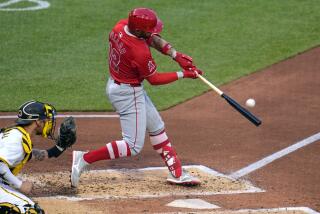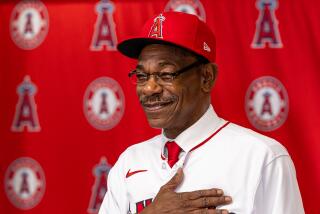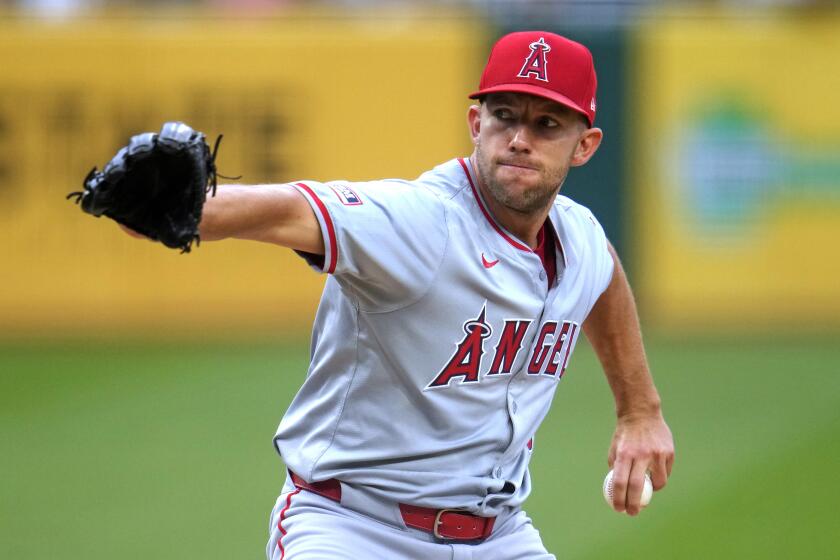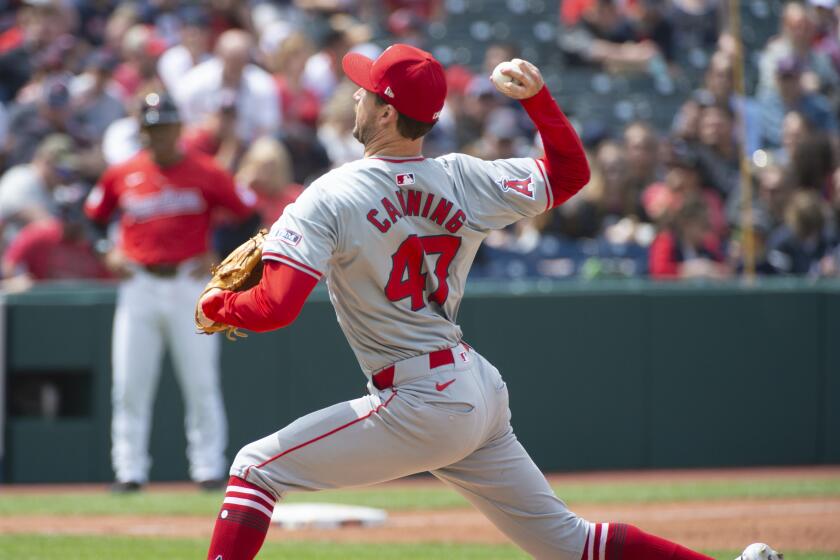Ace Uninhibited
There was at least one benefit to the Angels’ offensive struggles in 2005 -- it may have been just the impetus right-hander John Lackey needed to reach his potential.
The Angels score two runs in games against Minnesota on July 17 and Oakland on Aug. 31? No problem. Lackey gives up only one in each game, and the Angels win both by 2-1 scores.
Need to hold the opponent down to give your sluggish offense a chance to win? Fifteen times in 33 starts last season, Lackey gave up two earned runs or fewer and threw six innings or more.
“Some of it was by necessity,” Lackey said of his 14-5 season, which included career highs for innings pitched (209) and strikeouts (199) and career lows for earned-run average (3.44) and opponents’ batting average (.258).
“We had to pitch well to win games, we had to find a way to get it done. Maybe some of that pressure might have helped, because you definitely had to lock it in early in games and focus on what you had to do.”
Lackey’s emergence as a more-than-dependable starter, a pitcher who would have been considered the ace of the 2005 staff if not for the efforts of Cy Young Award winner Bartolo Colon, has cast him in a different light as the Angels prepare for 2006.
Though he’s 27 and beginning only his fourth full season in the big leagues, Lackey is no longer the big Texan who could dominate if he puts it all together. Lackey did dominate in 2005, so he can no longer be considered a work in progress.
“When faces in the clubhouse change every year and you go from being a young guy with less service time to a player with more time and more success, you see yourself in a different light, in a different place with the team,” Angel pitching coach Bud Black said. “You become more of a leader, you’re more in the forefront. You take on the responsibilities of a front-line starter, you maintain the work ethic young pitchers have to live up to. You act a little different with the press, your teammates. We’ve seen these strides with John, and we’ll see more.”
After seeing Lackey burst onto the scene in 2002, when he joined the rotation in June and went 9-4 with a 3.66 ERA in 18 games in the heat of a playoff race and won Game 7 of the World Series against the San Francisco Giants, the Angels were convinced Lackey had front-of-the-rotation potential.
But for the next two years, Lackey mixed flashes of brilliance with stretches of inconsistency, going 24-29 with a 4.65 ERA in 65 starts and too often letting his frustration get the best of him. Mental lapses led to bad pitches, and mistakes often turned one-run innings into three- and four-run innings.
The 6-foot-6, 235-pound Lackey, who has been slowed by minor shoulder stiffness this spring, was beginning to realize that a repertoire of two primary pitches, no matter how good his fastball and curve were, might not be enough to excel in the big leagues.
“When you have two pitches and one’s not working, you’re in trouble that night,” Lackey said. “I had to have more options to get through games and have a chance to win.”
Lackey began using a changeup and a cut fastball last season. He also altered his mechanics, shortening the stride of his front leg to give him more of an upright delivery and put his pitches on more of a downward plane.
But in his first three starts of 2005, Lackey was rocked for 14 earned runs and 18 hits in 15 1/3 innings, going 1-1 with an 8.22 ERA. Black and Manager Mike Scioscia held a lengthy closed-door meeting with Lackey, telling him to trust his stuff, especially his curve, and to focus on nothing but the next pitch.
Lackey gave up one earned run in five innings of his next start, and though he got no decision in a 4-3 loss to Oakland, it was a turning point. Lackey went 13-4 with a 3.07 ERA from then on and made two strong starts in the American League division series against the New York Yankees, giving up three runs and seven hits in 11 1/3 innings of two no-decisions.
“There’s a definite progression, not only from the physical standpoint of finding his stuff but from the mental part of pitching,” Scioscia said. “How do you handle adversity, the bloop hit, the pitch that is not called a strike, the play that wasn’t made? He understands getting to the next pitch.... You knew the makeup was there. With any young pitcher, experience is the teacher.”
With every quality start, Lackey’s confidence seemed to grow, and by the All-Star break he began to exude the kind of swagger the Angels hadn’t seen since 2002.
“It’s a feeling of, ‘Hey, I belong,’ and you sort of see how you stand in the game, how you match up with other players in the major leagues,” Black said. “It gives you a good sense of confidence that you’ve achieved and you have more of an upside.”
Lackey’s success resulted in a $3.76-million contract this winter, his first year of arbitration eligibility, and an expectation that Lackey will match the high level of consistency and excellence he enjoyed in his breakout year.
Lackey’s response to such pressure? Bring it on.
“Last year was big for my confidence,” Lackey said. “I was pitching with a different group of people, and I enjoyed that. I want to stay in that group of elite pitchers in the league. I ran up against some good pitchers and held my own.... I hope the other team thinks they better play well that night to beat me.”
*
(BEGIN TEXT OF INFOBOX)
For starters
John Lackey’s statistics with the Angels:
*--* Year Starts Innings W-L ERA 2002 18 108 1/3 9-4 3.66 2003 33 204 10-16 4.63 2004 32 198 1/3 14-13 4.67 2005 33 209 14-5 3.44
*--*
More to Read
Go beyond the scoreboard
Get the latest on L.A.'s teams in the daily Sports Report newsletter.
You may occasionally receive promotional content from the Los Angeles Times.







